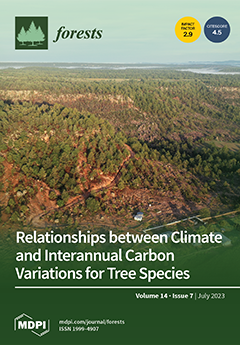As objects for reforestation, the least studied are carbonate substrates, which have a number of specific features in terms of mineral composition, the exchange of nutrients, and biological activity. The use of biological preparations of a consortium of bacteria of the genus
Bacillus and mycorrhizal fungi of the genus
Glomus in growing seedlings of Scots pine (
Pinus sylvestris L.) on carbonate substrates provides the metabolic products; soluble and microelement salts function as catalysts for chemical reactions of exudates and soil products; and a greater amount of plant heavy metals (HM) Cu, Zn, Cd, and Pb accumulate in the soil. Among HMs, the random factors most strongly determined an accumulation of Cd (the influence rate of random factors h
2x = 34.6%) and Pb (the influence rate of random factors h
2x = 21.7%) in the plants. A trend of all studied HMs higher uptake by the Cretaceous pine (
Pinus sylvestris var.
cretacea (Kalen.) Kom.) in comparison with the
P. sylvestris ecotype is revealed. Against the biological preparation background of Biogor KM and MycoCrop
®, a greater value of the HM’s biological absorption in comparison with the option without biological preparations is noted. This process occurs against a background of a significant increase in the nitrification capacity in the chalk fine-grained substrate (soil aggregates < 1 mm in size), which is an indirect indicator of an increased intensity of microbiological processes. Spearman’s correlation was noted between the coefficient of accumulation of Cu, Zn, Cd, and Pb in the dry matter of Scots pine (
P. sylvestris) seedlings and the nitrification capacity of substrate (r
s = 0.610–0.744,
p < 0.05), as well as the relationship between the nitrification capacity index of substrate and the coefficient of biological absorption of copper, zinc, and cadmium (r
s = 0.543–0.765,
p < 0.05). No relationship was found between the coefficient of biological absorption of lead and other soil chemical property indicators. HM absorption by plants was random. No correlations have been established between an accumulation of HMs and a content of total nitrogen, an absolute value of nitrate nitrogen, a humus content, or a pH. The significance of the work is the possibility of providing reliable reforestation with Scots pine (
P. sylvestris) and Cretaceous pine (
P. sylvestris var.
cretacea) on the chalk outcrops using the biological preparations Biogor KM, MycoCrop
®, and BGT* methodology and ensuring soil phytoremediation from HMs.
Full article





